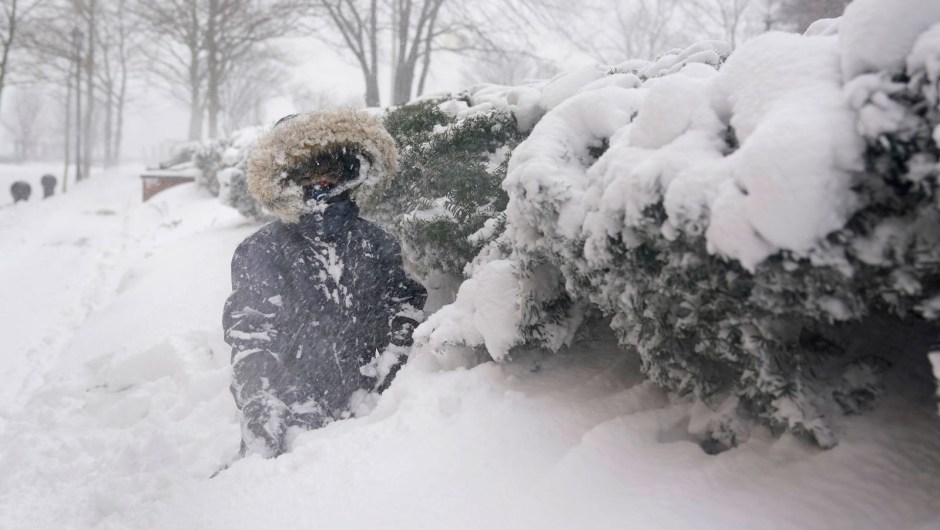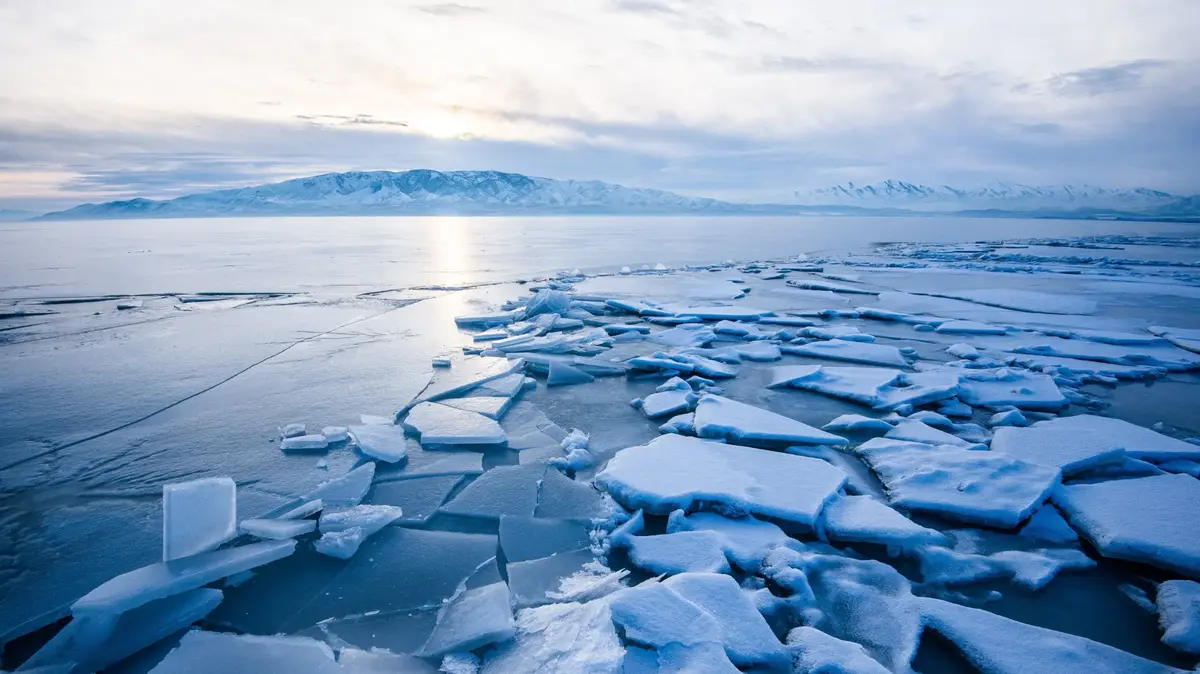How much snow has fallen from the winter storm in the US?
3:46
(CNN) ––
It's about to get so cold that the boiling water will freeze quickly, in a matter of minutes.
The process could happen in just half an hour and will be a shock to the system, even for those who are used to the harshest winters.
The coldest air of the season will be directed south and no one will be left out.
Every state in the US, including Hawaii, will have freezing temperatures next Monday morning.
Groundhog Day: Phil predicts winter will last six more weeks
This includes 86% of the country and 235 million people.
A blast of arctic air is responsible for much of that.
The polar vortex is responsible
This extreme cold is due to a complement of the polar vortex, a large zone of low pressure located near the poles.
During the winter months it decomposes and sends cold air south that has been locked in.
The polar vortex can be responsible for excessively cold temperatures and large drops of cold air.
Also, the polar vortex has been further weakened this year by sudden stratospheric warming that occurs about six times in a decade.
advertising
This will cause the polar vortex to weaken even more and bring outbreaks of cold air to the US It allows the cold air that has been trapped high in the atmosphere to be released to the south and that generates extremely cold conditions in the surface.
https://dynaimage.cdn.cnn.com/cnn/animations/w_1100,ac_none/210202121659-desktop-weather-polar-vortex-2021.mp4
The cold trend will continue for the next 10 days.
A quick freeze may affect the Midwest: consequences of the polar vortex
Cold air will begin to descend through the upper Midwest and Midwest on Saturday.
Places in central Wisconsin could see temperatures dip to -31.6 degrees Celsius on Sunday, with highs scrambling to reach zero.
It's a blow to some of the harshest populations in the Midwest when it comes to the cold.
A fierce winter storm covered parts of the northeastern U.S. and more snow is expected Tuesday.
"We get between 2 and 3 of these cold waves every year," said Marcia Cronce, a meteorologist with the National Meteorological Service.
"The coldest air of the season awaits us, it will be shocking," he added.
With highs near freezing for much of the week, Madison will post even lower numbers by the end of the week: a high of -12 degrees Celsius for Saturday.
And it's not just cold air, the wind also plays a role.
Wind chill in areas outside of Milwaukee could reach between -28.8 and -34.4 degrees Celsius on Saturday night and Sunday.
After the snow on Thursday, the coldest air of the season is looking to settle into southern WI this weekend.
#swiwx pic.twitter.com/rcMxQ3uaCH
- NWS Milwaukee (@NWSMilwaukee) February 2, 2021
This cold air will come immediately after the snow expected on Thursday.
Which could lead to even more problems.
"Whatever amount of snow and half-melting rainfall we get on Thursday and Friday, they will freeze quickly," Cronce said.
"You will have little time to clear the snow before temperatures plummet rapidly and roads freeze quickly."
Highs for much of the Midwest will be about 3 degrees Celsius below normal.
Chicago will remain in single digits on Sunday and Monday.
Millions of people are on alert for the first snow storm of 2021 in the US.
The National Weather Service (NWS) office in Chicago also warned of dangerous temperatures during their forecasting discussion.
«A mass of air from icy cold to extreme cold that arrives during the weekend and continues until the following week, with minimum temperatures in some places of -23.3 degrees Celsius or less and a wind chill of -28.8 and - 34.4 degrees Celsius, or even colder, is possible from Sunday night to Monday, "they indicated.
If the right clothing is not used, frostbite could occur in as little as 30 minutes.
An active weather pattern as of late will also turn significantly colder this weekend into early next week.
Confidence is increasing in widespread sub-zero lows, with single digit highs possible.
Good time to brush up on cold weather safety!
https://t.co/9Sv6zy4s3r #ILwx #INwx pic.twitter.com/R7Fbg5dyaE
- NWS Chicago (@NWSChicago) February 2, 2021
In fact, 16 Midwestern states and the Great Plains will experience freezing temperatures on Monday morning.
That affects 16% of the country and 41 million people.
Some areas may experience the coldest temperatures in years
So the cold air will continue its journey south and east as it spreads over much of the south early next week.
There is still some uncertainty about how far south the Arctic blast will reach.
Earlier this week, forecast models showed places like Atlanta will have the coldest air since 2018.
"If you see the low of -7.2 degrees Celsius on Monday morning, that would be the coldest temperature we've been in in three years," said NWS Atlanta meteorologist Kyle Thiem.
The city has not had temperatures below -6 degrees Celsius since January 2018.
Temperatures in Atlanta will be 2 degrees Celsius below normal for this cold air event.
However, those numbers will not break records.
Atlanta's all-time low for February 8 is zero -17 degrees Celsius.
But, when wind chill is taken into account, the temperature feels like in the single digits.
1 of 11
|
Steve Kent skiing through Times Square on Monday.
John Minchillo / AP
2 of 11
|
Arturo Diaz, 4, plays in Hoboken, New Jersey, on Monday.
Seth Wenig / AP
3 of 11
|
A woman walks in Central Park in New York.
As of 1 p.m. Monday, Central Park had reported 34 inches of snow and it was still snowing, the National Weather Service said.
Timothy A. Clary / AFP / Getty Images
4 of 11
|
Street vendor wrapped in a blanket as snow falls in Times Square on Monday.
Jeenah Moon / Bloomberg / Getty Images
5 of 11
|
The White House grounds covered in snow Sunday.
Joshua Roberts / Getty Images
6 of 11
|
A truck pulls off Route 120 near MetLife Stadium in East Rutherford, New Jersey, on Sunday night.
Danielle Parhizkaran / NorthJersey.com / USA Today Network
7 of 11
|
A pedestrian walks down a snow-covered sidewalk in New York's Chinatown neighborhood.
John Minchillo / AP
8 of 11
|
Workers hold snow shovels on the New York City subway.
Angela Weiss / AFP / Getty Images
9 of 11
|
A worker cleans the sidewalks in Times Square on Monday.
John Minchillo / AP
10 of 11
|
Workers clean the streets of New York on Monday.
CNN meteorologists say that around 24 inches of snow may cover the city before the storm passes.
Spencer Platt / Getty Images
11 of 11
|
Sleds go up a hill in Chicago.
Humboldt Park on Monday.
Scott Olson / Getty Images
"Our biggest concerns are people who are outside for long periods," Thiem said.
"We always advise anyone outside to dress in layers and try to take a break and seek shelter every 30 minutes or so," he said.
The east coast can experience temperature changes
Temperatures in the Mid-Atlantic and Northeast will plummet this Monday.
The city of Washington will drop to -8 degrees Celsius on Tuesday morning.
And it probably won't be above freezing for the rest of the week.
Early morning lows for New York City and Philadelphia will see temperatures below -11 degrees Celsius on Monday morning, with highs only at -6 degrees Celsius by Tuesday afternoon.
Boston will also drop below -11 degrees Celsius on Tuesday morning and it is quite possible that it will not exceed -6 degrees Celsius for the rest of the week.
This comes on the heels of Boston's warmer-than-normal January and a late start to the snow season.
The weather could make up for that in February.
The thaw of the Great Lakes
The Great Lakes have set records this winter for lack of ice.
Lake Eerie is well below what it should be with regards to ice concentration.
The lake is only 1.6% frozen right now, when it should be around 60%.
This according to the Great Lakes Environmental Research Laboratory.
The next cold snap will help to freeze the lakes a bit.
But, it probably won't help them get to where they should be when it comes to the ice sheet.
According to NOAA, winter forecasts estimate that the Great Lakes will only reach about 30% this season.
Which is well below the average ice concentration, which is 63%.
Significant changes in the amount of ice cover over an extended period could have huge implications for the climate of the Great Lakes region.
Less ice cover, combined with warmer surface temperatures, will lead to increased lake-effect precipitation in the future.
snow wave of cold polar vortex





